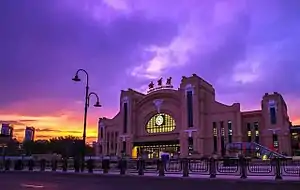Harbin railway station
Harbin railway station (simplified Chinese: 哈尔滨站; traditional Chinese: 哈爾濱站; pinyin: Hā'ěrbīn Zhàn) is a railway station of Jingha railway, Binsui Railway, Labin Railway, Binbei Railway and Binzhou Railway. The station is in the town of Harbin, Heilongjiang, China. The under construction Line 2 of Harbin Metro will also build a station here, and it will be opened in 2020.
 Harbin railway station | |||||||||||||||||||||
| Location | Tielu Jie, Nangang District, Harbin, Heilongjiang China | ||||||||||||||||||||
| Coordinates | 45°45′28″N 126°37′28″E | ||||||||||||||||||||
| Operated by | Harbin Railway Bureau, China Railway Corporation | ||||||||||||||||||||
| Line(s) | Jingha railway, Binsui Railway, Binzhou Railway, Labin Railway, Binbei Railway, Jingha High-Speed Railway, Hada High-Speed Railway | ||||||||||||||||||||
| Platforms | 14 | ||||||||||||||||||||
| Connections |
| ||||||||||||||||||||
| Other information | |||||||||||||||||||||
| Station code |
| ||||||||||||||||||||
| Classification | Top Class station | ||||||||||||||||||||
| History | |||||||||||||||||||||
| Opened | 1899 | ||||||||||||||||||||
| Previous names | Songhuajiang | ||||||||||||||||||||
| Services | |||||||||||||||||||||
| |||||||||||||||||||||
History
Songhuajiang station (Chinese: 松花江站; pinyin: Sōnghuājiāng Zhàn; lit. 'Songhua River railway station') was opened in October, 1899.[1] It was renamed Harbin Station in July, 1903.[2] It was renovated in 1960, 1972, 1989 and 2002. In 2015, construction of new Harbin railway station began, using the design of the original Art Nouveau style in the 1903-built old station. On 31 August 2017, the north terminal of newly built Harbin railway station opened for public service.[3] The main south terminal, which in situ redevelopment, is planned to be open in 2018.
On October 26, 1909, Korean nationalist An Jung-geun assassinated Itō Hirobumi (伊藤博文), the first Prime Minister of Japan, on the platform at Harbin Station. Itō had been Japan's Resident-General in Korea until a few months before his assassination. A memorial hall honoring An Jung-geun was opened on Sunday, 19 January 2014 in Harbin. The hall, a 200-square meter room, features photos and memorabilia.[4]
External links
| Wikimedia Commons has media related to Harbin Railway Station. |
- Harbin Railway Station Official website(in Chinese)
References
- 哈尔滨火车站简介 Archived 2009-12-17 at the Wayback Machine(in Chinese)
- 哈尔滨市志 交通志(in Chinese)
- 大美哈站北站房投用 设施尽显欧式范儿(组图)
- Memorial hall for Korean nationalist Ahn Jung Geun opens in China